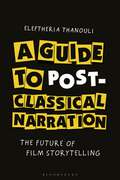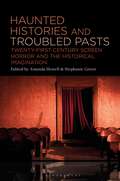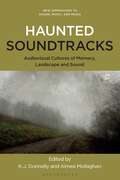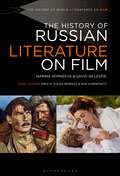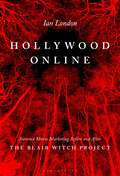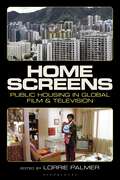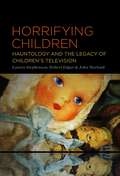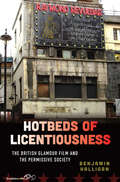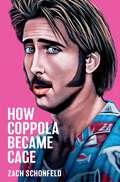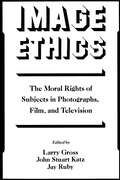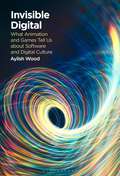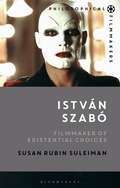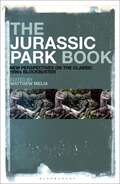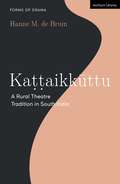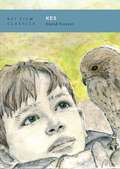- Table View
- List View
A Guide to Post-classical Narration: The Future of Film Storytelling
by Dr. Eleftheria ThanouliIn A Guide to Post-classical Narration, Eleftheria Thanouli expands and substantially develops the innovative theoretical work of her previous publication, Post-classical Cinema: an International Poetics of Film Narration (2009). A Guide to Post-classical Narration: The Future of Film Storytelling presents a concise and comprehensive overview of the creative norms of the post-classical mode of narration. With dozens of cases studies and hundreds of color stills from films across the globe, this book provides the definitive account of post-classical storytelling and its techniques. After surfacing in auteur films in varied production milieus in the 1990s, the post-classical options continued to gain ground throughout the 2000s and 2010s, gradually fertilizing several mainstream productions in Hollywood. From Lars von Trier's Europa (1991) to Zack Snyder's Army of the Dead (2021) and Baz Luhrmann's Elvis (2022), the post-classical narration has shown not only impressive resilience but also tremendous creativity in transforming its key formal principles, such as fragmented and multi-thread plotlines, hypermediated realism, parody, graphic frame construction, complex chronology, and intense self-consciousness. Through the meticulous textual analysis of the post-classical works, Eleftheria Thanouli addresses head-on a series of methodological questions in narrative research and brings the tradition of historical poetics back into the limelight. By reinforcing her previous work with numerous new films as well as more nuanced narrative terms and concepts, she not only strengthens her position on post-classical cinema but also establishes the relevance of formalist analysis in the study of film today.
Halloween (Devil's Advocates)
by Murray LeederThe 1970s represented an unusually productive and innovative period for the horror film, and John Carpenter's Halloween (1978) is the film that capped that golden age – and some say ruined it, by ushering in the era of the slasher film. Considered a paradigm of low-budget ingenuity, its story of a seemingly unremarkable middle-American town becoming the site of violence on October 31 struck a chord within audiences. The film became a surprise hit that gave rise to a lucrative franchise, and it remains a perennial favourite. Much of its success stems from the simple but strong constructions of its three central characters: brainy, introverted teenager Laurie Strode, a late bloomer compared to her more outgoing friends, Dr. Loomis, the driven, obsessive psychiatrist, and Michael Myers, the inexplicable, ghostlike masked killer.Film scholar Murray Leeder offers a bold and provocative study of Carpenter's film, which hopes to expose qualities that are sometime effaced by its sequels and remakes. It explores Halloween as an unexpected ghost film, and examines such subjects as its construction of the teenager, and the relationship of Halloween the film to Halloween the holiday, and Michael Myers's brand of "pure evil." It is a fascinating read for scholars and fans alike.
Haunted Histories and Troubled Pasts: Twenty-First-Century Screen Horror and the Historical Imagination
Haunted Histories and Troubled Pasts speaks to how a transnational array of recent screen entertainments participate, through horror, in public discourses of history, the social and creative work of reshaping popular understanding of our world through the lens of the past.Contemporary film and television – and popular screen cultures more generally – are distinguished by their many and varied engagements with history, including participation in worldwide movements to reconcile past losses and injuries with present legacies. The chapters in this collection address themselves to 21st-century screen horror's participation in this widespread fascination with and concern for the historical - its recurrent reimagining of the relation between the past and present, which is part of its inheritance from the Gothic. They are concerned with the historical work of horror's spectral occupations, its visceral threats of violence and its capacity for exploring repressed social identities, as well as the ruptures and impositions of colonization and nationhood.Trauma is a key theme in this book, examined through themes of war and genocide, ghostly invasions, institutionalized abuse, apocalyptic threat and environmental destruction. These persistent, fearful reimaginings of the past can take many lurid – sometimes tritely generic – forms. Together, these chapters explore and reflect upon horror's ability to speak through them to the unspoken of history, to push the boundaries and probe the fault-lines and ideological impositions of received historical narratives – while reminding us that history and the historical imagination persist as sites of contention.
Haunted Soundtracks: Audiovisual Cultures of Memory, Landscape, and Sound (New Approaches to Sound, Music, and Media)
The turn of the millennium has heralded an outgrowth of culture that demonstrates an awareness of the ephemeral nature of history and the complexity underpinning the relationship between location and the past. This has been especially apparent in the shifting relationship between landscape, memory and sound in film, television and other media. The result is growing interest in soundtracks, as part of audiovisual culture, as well as an interest in the spectral aspects of culture more generally. This collection of essays focuses on audiovisual forms that foreground landscape, sound and memory. The scope of inquiry emphasises the ghostly qualities of a certain body of soundtracks, extending beyond merely the idea of 'scary films' or 'haunted houses.' Rather, the notion of sonic haunting is tied to ideas of trauma, anxiety or nostalgia associated with spatial and temporal dislocation in contemporary society. Touchstones for the approach are the concepts of psychogeography and hauntology, pervasive and established critical strategies that are interrogated and refined in relation to the reification of the spectral within the soundtracks under consideration here.
The History of Russian Literature on Film (The History of World Literatures on Film)
by Marina Korneeva David GillespieUnlike most previous studies of literature and film, which tend to privilege particular authors, texts, or literary periods, David Gillespie and Marina Korneeva consider the multiple functions of filmed Russian literature as a cinematic subject in its own right-one reflecting the specific political and aesthetic priorities of different national and historical cinemas. In this first and only comprehensive study of cinema's various engagements of Russian literature focusing on the large period 1895-2015, The History of Russian Literature on Film highlights the ways these adaptations emerged from and continue to shape the social, artistic, and commercial aspects of film history.
Hollywood Online: Internet Movie Marketing Before and After The Blair Witch Project
by Dr. Ian LondonHollywood Online provides a historical account of motion picture websites from 1993 to 2008 and their marketing function as industrial advertisements for video and other media in the digital age.The Blair Witch Project is the most important example of online film promotion in cinema history. Over the last thirty years only a small number of major and independent distributors have converted internet-created buzz into box-office revenues with similar levels of success. Yet readings of how the film's internet campaign broke new ground in the summer of 1999 tend to minimize, overlook or ignore the significance of other online film promotions. Similarly, claims that Blair initiated a cycle of imitators have been repeated in film publications and academic studies for more than two decades. This book challenges three major narratives in studies about online film marketing: Hollywood's major studios and independents had no significant relationship to the internet in the 1990s; online film promotions only took off after 1999 because of Blair; and Hollywood cashed-in by initiating a cycle of imitators and scaling up corporate activities online. Hollywood Online tests these assumptions by exploring internet marketing up to and including the film's success online (Pre-Blair, 1993-9), then by examining the period immediately after Blair (Post-Blair, 2000-8) which broadly coincides with the rise and decline of DVD, as well as the emergence of the social media sites MySpace, Facebook and Twitter.
Home Screens: Public Housing in Global Film & Television
How do film and television makers around the world depict public housing? Why is public housing so often chosen as the backdrop for drama, horror, social critique, rebellion, violence, artistic creativity, explorations of race relations and political intrigue?Home Screens answers these questions by examining the ways in which socialized housing projects around the world are represented on screen. The volume brings together a diverse group of interdisciplinary scholars, who explore documentary and fictional portrayals of the architecture of public housing, and the communities that inhabit it, ranging from the 1950s to the present. Examining international film and media texts such as Die Architekten (1990), Swagger (2016), Cooley High (1975), Mee-Pok Man (1995), Treme (2010–2013), Mamma Roma (1962), The Pruitt-Igoe Myth (2011), and Below the Lion Rock (1972–1976), essays within this book consider public and private attitudes toward socialised housing, explaining how onscreen representations shape perceptions of these ubiquitous, often-stigmatized urban locations.
Horrifying Children: Hauntology and the Legacy of Children’s Television
Horrifying Children examines weird and eerie children's television and literature via critical analysis, memoir and autoethnography.There has been an explosion of interest in the impact of children's television and literature of the late twentieth century. In particular, the 1970s, '80s and '90s are seen as decades that shaped a great deal of the contemporary cultural landscape. Television of this period dominated the world of childhood entertainment, drawing freely upon literature and popular culture, like the Garbage Pail Kids and Stranger Things, and much of it continues to resonate powerfully with the generation of cultural producers (fiction writers, screenwriters, directors, musicians and artists) that grew up watching the weird, the eerie and the horrific: the essence of 21st-century Hauntology. In these terms this book is not about children's television as it exists now, but rather as it features as a facet of memory in the 21st century. As such it is the legacy of these television programmes that is at the core of Horrifying Children. The 'haunting' of adults by what we have seen on the screen is crucial to the study. This collection directly addresses that which 'scared us' in the past insomuch as there is a correlation between individual and collective cultural memory, with some chapters providing an opportunity for situating existing explorations and understandings of Gothic and Horror TV within a hauntological and experiential framework.
Horror That Haunts Us: Nostalgia, Revisionism, and Trauma in Contemporary American Horror Film and Television
Horror’s pleasures fundamentally hinge on looking backward, either on destabilising trauma, or as a period of comfort and happiness which is undermined by threat. However, this stretches beyond the scares on our screens to the consumption and criticism of the monsters of our past. The horror films of our youth can be locations of psychological and social trauma, or the happy place we go back to for comfort when our lives become unsettled. Horror That Haunts Us: Nostalgia, Revisionism, and Trauma in Contemporary American Horror is a collection of essays that brings together multiple theoretical and critical approaches to consider the way popular horror films from the last fifty years communicate, embody, and rework our view of the past. Whether we look at our current relationship to the scary movies of decades ago as personal or cultural memory, the way historical and sociopolitical events and frameworks – especially traumas – reframe the way we look at our pasts, or even the way recent horror films and video games look back at our past (and the past of the genre itself) through a filter of experience and history, this collection will show the close relationship between nostalgia and popular horror. These essays also demonstrate a range of unique and diverse points of view from both established and emerging scholars on the subject of horror and the past. Edited by seasoned horror experts Karrá Shimabukuro and Wickham Clayton, Horror That Haunts Us is a book with the aim of examining why we return again and again to certain popular horror films, either as remakes or reboots or as the basis for pastiche and homage.
Hotbeds of Licentiousness: The British Glamour Film and the Permissive Society
by Benjamin HalliganHotbeds of Licentiousness is the first substantial critical engagement with British pornography on film across the 1970s, including the “Summer of Love,” the rise and fall of the Permissive Society, the arrival of Margaret Thatcher, and beyond. By focusing on a series of colorful filmmakers whose work, while omnipresent during the 1970s, now remains critically ignored, author Benjamin Halligan discusses pornography in terms of lifestyle aspirations and opportunities which point to radical changes in British society. In this way, pornography is approached as a crucial optic with which to consider recent cultural and social history.
Hotbeds of Licentiousness: The British Glamour Film and the Permissive Society
by Benjamin HalliganHotbeds of Licentiousness is the first substantial critical engagement with British pornography on film across the 1970s, including the “Summer of Love,” the rise and fall of the Permissive Society, the arrival of Margaret Thatcher, and beyond. By focusing on a series of colorful filmmakers whose work, while omnipresent during the 1970s, now remains critically ignored, author Benjamin Halligan discusses pornography in terms of lifestyle aspirations and opportunities which point to radical changes in British society. In this way, pornography is approached as a crucial optic with which to consider recent cultural and social history.
House of Usher (Devil's Advocates)
by Evert van LeeuwenDespite being the product of Roger Corman’s AIP exploitation studio, House of Usher enjoys a high standing. But while the impact and cult status of Corman’s Edgar Allan Poe cycle is often discussed in histories of gothic, horror, and exploitation cinema, no extended analysis and critical discussion has been published to date that explores specifically the aesthetic appeal of House of Usher. This Devil’s Advocate provides a complete study of the aesthetic appeal of Corman’s influential first Poe picture.Evert van Leeuwen explores the underlying narrative structure borrowed from Poe’s original story and shows how closely Richard Matheson’s script followed Poe’s theory of short fiction. He goes on to explore the formal techniques of allegory and symbolism employed to represent the house as a monster before focusing on Corman’s imagery, showing how the use of specific camera angles, lenses, colors, and sound effects create and sustain the simultaneously morbid and beautiful atmosphere of gothic decay. Finally, he situates horror icon Vincent Price’s performance as Roderick Usher in the context of the nineteenth-century Romantic misfit and the postwar countercultural antihero, two closely related cultural identities.
How Coppola Became Cage
by Zach SchonfeldAn in-depth look at one of the film industry's most audacious working actors In 1982, a gangly teenager named Nicolas Coppola made his film debut and changed his name to Nicolas Cage, determined to distance himself from his famous family. Once he achieved stardom as the rebel hunk of 1983's Valley Girl, Cage began a career defined by unorthodox risks and left turns that put him at odds with the stars of the Brat Pack era. How Coppola Became Cage takes readers behind the scenes of the beloved cult movies that transformed this unknown actor into an eccentric and uncompromising screen icon with a wild-eyed gift for portraying weirdos, outsiders, criminals-and even a romantic capable of seducing Cher. Author Zach Schonfeld traces Cage's rise through the world of independent cinema and chronicles the stories behind his career-making early performances, from the method masochism of Birdy to the operatic torment of Moonstruck and abrasive expressionism of Vampire's Kiss, culminating with the astonishing pathos of Leaving Las Vegas. Drawing on more than 100 new interviews with Cage's key collaborators--including David Lynch, Martha Coolidge, John Patrick Shanley, and Mike Figgis--How Coppola Became Cage offers a revealing portrait of Cage's wildly intense devotion to his performances behind the scenes and his creative self-discovery as he drew on influences as far-flung as silent cinema and German Expressionism. These were all crucial ingredients in the creation of a singular acting style that rejects the limits of realism. Brimming with previously untold stories and insights, How Coppola Became Cage both revels in and demystifies Cage's onscreen eccentricities. No other modern actor has explored such profound creative extremes while bending the boundaries of good taste. Here is the origin story of an actor who truly is wild at heart and weird on top.
I Walked With a Zombie (Devil's Advocates)
by Clive DawsonI Walked with a Zombie (1943), Val Lewton's second feature for RKO Radio Pictures, was described by critic Robin Wood as 'perhaps the most delicate poetic fantasy in the American Cinema.' Following immediately in the wake of the groundbreaking Cat People (1942), Zombie pioneered an even more radical narrative approach yet proved to be the critical and commercial equal of its predecessor, cementing the reputation of both Lewton and his director, Jacques Tourneur. Despite the lurid, studio-imposed title, I Walked with a Zombie is a subtle and ambiguous visual poem that advanced a daring condemnation of slavery and colonialism at a time when such themes were being actively suppressed by government censors. Clive Dawson charts the complex development and production of the project, essential to understanding the concerns of the filmmakers in the context of wartime Hollywood, then analyses the film in detail, referencing a broad range of academic studies of the audio-visual text and distilling new insight into its layers of meaning. Finally, he explores the film's reception, and the influence it exerted on the horror genre and beyond. Extensive primary research has uncovered a wealth of previously unpublished new material that solves many unanswered questions and dispels various myths about this utterly unique film.
Image Ethics: The Moral Rights Of Subjects In Photographs, Film, And Television
by Larry Gross John Stuart Katz Jay RubyInvisible Digital: What Animation and Games Tell Us about Software and Digital Culture
by Aylish WoodInvisible Digital helps us makes sense of something we cannot see by presenting an innovative approach to digital images and digital culture. At its heart is a novel method for exploring software used in the creation of moving images as markers of converging cultural, organizational and technological influences. The three main case studies of Invisible Digital are the animated feature Moana (2016) and the computer games No Man's Sky (2016) and Everything (2017). All three were created using procedural techniques: simulation software for Moana, and procedural content generation for No Man's Sky and Everything. Production culture disclosures associated with procedural techniques often emphasize the influences of automated systems and their algorithms, making them ideal for a study that interrogates digital processes. The approach of Invisible Digital is informed by relational theories and the concept of entanglement based on materialist perspectives, combined with insights from work that more explicitly interrogates algorithms and algorithmic culture. Aylish Wood employs the notion of assemblages to introduce the concept of material-cultural narratives. Using this conceptual framework, she draws out material-cultural narratives for each case study to demonstrate what they reveal about software and digital culture. These analyses of software provide a widely applicable method through which moving image studies can contribute more fully to the wider and growing debates about algorithmic culture.
István Szabó: Filmmaker of Existential Choices (Philosophical Filmmakers)
by Susan Rubin SuleimanIstván Szabó is one of the few Hungarian filmmakers to have earned a major international reputation over the past half century. This thoughtful and original book is the first examination of Szabó's contribution to contemporary thought, engaging the troubled history of Europe in the 20th and 21st centuries. István Szabó's importance as a filmmaker lies not only in his attention to film's formal elements but in his deep and ongoing engagement with some of the most urgent ethical and existential questions of our time. With detailed analyses of István Szabó's major films, from his 1960s works to his Academy Award for Best Foreign Film winner, Mephisto, and on through Szabó's last film in 2020, Final Report, Susan Rubin Suleiman focuses on four important questions pertaining to existential choice: to leave home or to stay in a communist country? To collaborate or not with an authoritarian regime? To affirm or to deny one's Jewishness in the face of antisemitism? To seek or to give up on community in the face of individual or national conflicts? Above all, Suleiman addresses the single most important philosophical question that haunts Szabó's work, as it does that of many other Central European intellectuals and filmmakers of our time. That is, how do individuals attempt, through the life choices they make or that are foisted on them, to create a viable self in extreme historical situations over which they have no control?
IT Chapters One and Two (Devil's Advocates)
by Alissa BurgerDrawing on critical analysis of film, the horror genre, the Gothic, and Stephen King scholarship, this book considers Andy Muschietti’s IT Chapter One (2017) and IT Chapter Two (2019) on multiple levels: as film (both as individual films and through their interconnected narrative), as adaptation, and as a barometer of the horror film’s popularity among fans. Key points of consideration include the significance of the fictional town of Derry as a traditionally Gothic “bad place,” the role of 1980s nostalgia in these two films, the complex navigation of memory and trauma, gender representation, queer representation, and the return of the repressed. The terrifying figure of Pennywise the clown is central to this analysis, including consideration of performance, costuming, and significance within the larger landscape of the “scary clown” popular culture trope, and through comparison to Tim Curry’s iconic performance in Tommy Lee Wallace’s 1990 miniseries. This Devil's Advocate contextualizes Muschietti’s films within the larger landscape of King’s literary and popular culture influence, as well as the debate surrounding “elevated” horror and the “horror boom” of the late 2010s.
It Follows (Devil's Advocates)
by Josh GrimmAmid a recent resurgence in horror films, David Robert Mitchell’s It Follows stands out as a particularly bold entry, a horror fan’s dream come true that sparked a renewed creativity. Pulling a robust 97% on Rotten Tomatoes, It Follows was hailed as a “teen movie you’ve never seen before,” a “creepy, mesmerizing exercise in minimalist horror,” “the best horror film in years,” and simply, “so damn good.” Mitchell uses a variety of approaches to reinvent genre bromides while simultaneously embracing and challenging tropes that audiences and filmmakers rely on a little too heavily. It Follows is one of the best because it is one of the most unique. In this Devil’s Advocate, Joshua Grimm focuses on how this film helped reinvent the rules of a horror movie, particularly along the lines of genre, style, sex, and gender.
Jacques Rivette and French New Wave Cinema: Interviews, Conversations, Chronologies
by James R RussoThis first comprehensive English collection of the interviews of Jacques Rivette (19282016) documents his career through chronology, filmography, bibliography, and image stills. A comprehensive introduction places this work in the wider context of twentieth-century social change. Rivettes films, like many of the works of the French New Wave, seem to have avoided the aging process entirely, remaining as playful, fresh, and quietly spectacular as the day they were made. Indeed, his body of work may be the most impressive of the French New Wave. Celine and Julie Go Boating (1974) has been recognized as possibly the best film to emerge from the post-New Wave era, even as Paris Belongs to Us (1961) is one of the best pictures to emerge from the New Wave itself. Rivette was hardly the most prolific director, however, and the length of his films has often counted against him. Nonetheless, his clinical, self-reflexive essays in film form reveal him as a cinematic purist whose commitment to the celluloid muse hardly diminished from the heady days of the early 1950s to the end of his career in 2009. Beyond inspiring the New Wave movement and continuing to reflect, and reflect on, its central tenets, Rivettes enduring contribution to the history of film is unquestionably evident in his sensitive treatment of the histories and destinies of women, especially through strong roles for actresses. During the six decades of his career, nonetheless, he struck a subtle balance not only between female and male characters, but also between political and personal obsession, between myth and fiction, between theater and cinema, in films that, in addition to having influenced such contemporary filmmakers as Claire Denis, Jim Jarmusch, Olivier Assayas, and David Lynch, continue to redefine the art of cinema around the world.
Ju-On: The Grudge (Devil's Advocates)
by Marisa HayesTakashi Shimizu's Ju-on franchise was a principal instigator in the rise of contemporary Japanese horror and its international popularity at the turn of the millennium. Following the success of Hideo Nakata's Ringu (1998), the first cinematic release of Ju-on: The Grudge in 2002 crystallized Japanese horror's rise to prominence and outlined the new decade's thematic interest in supernatural technology and fear of contagions, while skillfully navigating domestic social concerns, such as Japan's growing elderly population and domestic violence.This Devil's Advocate explores the production roots of Ju-on The Grudge, followed by a critical reading of the film that highlights its essential themes and motifs, in addition to a section on cultural influences, before concluding with a section on Shimizu's continued involvement with the Ju-on franchise and its ongoing legacy. The book serves as an excellent primer for readers without prior knowledge of Japanese horror or the Ju-on film cycle, while providing fresh perspectives on the film that makes it equally appealing to J-horror aficionados.
The Jurassic Park Book: New Perspectives on the Classic 1990s Blockbuster
The definitive 1990s blockbuster, Steven Spielberg's Jurassic Park met with almost universal critical and popular acclaim, broke new ground with its CGI recreation of dinosaurs, and started one of the most profitable of all movie franchises. To mark the film's 30th anniversary, this exciting illustrated collection of new essays interrogates the Jurassic Park phenomenon from a diverse range of critical, historical, and theoretical angles. The primary focus is on Jurassic Park itself but there is also discussion of the franchise and its numerous spin-offs.As well as leading international scholars of film studies and history, contributors include experts in special effects, science on screen, fan studies, and palaeontology. Comprehensive, up to date, and accessible, The Jurassic Park Book appeals not only to students and scholars of Hollywood and contemporary culture, but also to the global audience of fans of the greatest of all dinosaur movies.
Kattaikkuttu: A Rural Theatre Tradition in South India (Forms of Drama)
by Hanne M. BruinThis is the first book to offer a clear introduction to Kattaikkuttu (or Terukkuttu), a vibrant, vocal and physical outdoor Tamil theatre tradition from India. It describes the theatre's characteristic heroic nature as expressed through its principal, male kattai characters, explores its history, social status and ritual context, and examines the production of all-night plays. After placing Kattaikkuttu in the wider, competitive context of the performing arts in India, Hanne M. de Bruin introduces readers to some of the debates about the form and provides an overview of the different elements that make up a Kattaikkuttu performance. It considers its performance spaces and the way the form has changed, such as its transition towards an independent and more professional theatre genre, as well as the opening up of the form to different castes and to women. It covers the production and frameworks of all-night performances, uses the Mahabharata play Karna Moksam as a case study and examines recent changes in the Kattaikkuttu repertory. In addition, the book looks in more detail at the role of the performer, including the training of a Kattaikkuttu novice, the performance score of actor-singers that underlie a specific role or vesam, and a seasoned performer's agency in interpreting well-known roles. Finally, the study turns to recent innovations, in particular the creation of new work and the Kattaikkuttu Gurukulam.
Kes (BFI Film Classics)
by David ForrestKen Loach's 1969 drama Kes, considered one of the finest examples of British social realism, tells the story of Billy, a working class boy who finds escape and meaning when he takes a fledgling kestrel from its nest.David Forrest's study of the film examines the genesis of the original novel, Barry Hines' A Kestrel for a Knave (1968), the eventual collaboration that brought it to the screen, and the film's funding and production processes. He provides an in depth analysis of key scenes and draws on archival sources to shed new light on the film's most celebrated moments. He goes on to consider the film's lasting legacy, having influenced films like Ratcatcher (1999) and This is England (2006), both in terms of its contribution to film history and as a document of political and cultural value. He makes a case for the film's renewed relevance in our present era of systemic economic (and regional) inequality, alienated labour, increasingly narrow educational systems, toxic masculinity, and ecological crisis. Kes endures, he argues, because it points towards the possibility for emancipation and fulfilment through a more responsive and nurturing approach to education, a more delicate and symbiotic relationship with landscape and the non-human, and an emotional articulacy and sensitivity shorn of the rigid expectations of gender.
